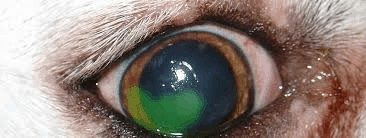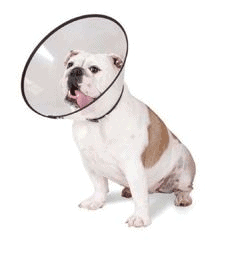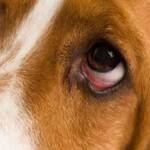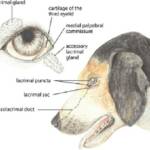One of the classic eye problems pet owners face are a red eye caused by irritation from an abrasion to the cornea, called an ulcer. The red eye of an ulcer is usually painful and the pet can be observed squinting or even rubbing at his/her face. The conjunctiva (the pink moist tissue lining the inner surfaces of the eyelids) can become very red. In more severe cases, the conjunctiva swells or puff up around the eye (a condition called chemosis). Any eye issue should be addressed by a veterinarian.

ulceration
Corneal Erosion / Ulceration
There are several causes of acutely red and painful eyes and one of the most common causes is a wound or scrape to the surface of the eye. The clear surface of the eye is called the cornea; because it is the outermost layer of the eye, it is prone to scrapes and tears. Common causes of corneal erosions include:
- Rough contact with plants, thorns, or bushes
- Scratches from another animal (note: the cat scratch wound can be especially serious as the wound quickly heals over, sealing infection within the eye.)
- Self-trauma (rubbing or scratching at a painful ear or even at the eye due to some other eye problem can lead to an inadvertent scratch to the eye.)
- Chemical irritation (such as getting shampoo in the eye during a bath.)
- Foreign body injury (plant material can get stuck under an eyelid and can scrape the cornea.)
A fluorescent stain is used to confirm if there is an ulcer or erosion. Normally, water will run smoothly off the surface of the cornea, like rain washing off a windshield. If the cornea is damaged, the stain will stick to the damaged area and look bright green under a fluorescent lamp.
Treatment
Antibiotics
A routine corneal ulcer or erosion should heal easily. Since the damaged cornea is at risk for becoming infected (or may even already be infected, as demonstrated by a discharge of pus), a topical antibiotic is needed and ideally should be used four times a day or more.
Since it is a rare pet owner that can accommodate any medication administration four times a day, we usually have to make do with three times a day but to properly sterilize the eye surface, the antibiotic should be used four times a day. Either drops or ointment can be used depending on the owner’s preference.
Atropine Sulfate
The second part of treatment is pain relief: Atropine 1% drops or ointment. The atropine acts by temporarily paralyzing the pupil’s ability to contstrict (the main source of pain is spasm in the pupil).
When this medication is used the pupil is expected to dilate (widen) and the pet may be reluctant to experience bright sunlight while taking this medication. Because the tear duct system is connected to the nose and mouth, the patient will also taste the above medications and atropine is famous for its bitter taste.
Dogs do not seem to mind this unduly but cats will drool shortly after the medication is given in an effort to get the taste out of their mouths. This is a normal reaction to the atropine as is a dilated pupil.

An Elizabethan collar (cone) may be needed to prevent self-trauma of the eye. If you think your pet will rub the eye, it is important to have the pet wear this collar until the erosion is healed. Be sure to request one if you think your pet needs it, and if you are given one be sure the pet wears it for the entire course of treatment.
Re-Check in One Week
It is important that the eye be stained again after one week of therapy. Most ulcers will have healed in this time but some will require an additional week. If the ulcer has not healed after two weeks, it is no longer considered routine. Some other procedures, and possibly a visit to a veterinary ophthalmologist, may be necessary.
If the inflammation associated with the ulcer goes deeper into the eye, the situation becomes more serious; it is important not to skip that one week re-check. If there is any question about the eye’s healing progress, the eye should be re-checked sooner.
It is important that the owner observe the progression of healing at home. If the eye is doing well but suddenly becomes more painful, if a discharge develops, or if the eye simply does not look right, have your vet recheck the pet sooner than the planned one-week appointment.


